I recently co-taught a Landscape/Adventure Sports workshop out in Moab, Utah with famous adventure photographer Tom Bol (and just all around nice guy). The class was great, the weather was great and we had a blast. But on the way back I started thinking about some lessons I’ve learned along these trips so I figured I’d share them with you today.
NOTE: Click on the photos to see them larger
Lesson 1 – Get up earlier than you think
The formula is simple. Get there 1 hour before sunrise. Plain and simple. You never know what snags you’ll hit (road blocks, detours, equipment). What happens if you’re on your way and you realize you forgot a lens or your tripod. If you have to turn around you’re screwed – you’ve missed sunrise because you left no extra time. But there’s another big reason to leave earlier than you think. If you happen to be going to a popular shooting location you’d better bet everyone else will have left early. Imagine walking up to a great sunrise shoot and seeing this.
Getting there early could be the difference between getting this shot of Mesa Arch (in Canyonlands National Park)
…or this shot
When I took the first photo, we were there about an hour before sunrise – the first ones at the spot. The second one was taken on another trip and several of the good spots were already gone. It’s not horrible but certainly not the shot we go there for. This next photo was taken at another sunrise shoot. What you can’t see are the 10 people standing on the ledge next to me and the guy’s foot (from a ledge above) I had to clone out on the far left side. Had we got there any later, there wouldn’t have been any places left to shoot from.
The moral of the story is that if you’re going to get up early, then do it right and get up really early. There’s no way around it. You’re gonna be tired whether you get up at 4am or 5am right?
Lesson 2 – Get ready the night before
I can’t stress this one enough. When you wake up at 4am you’re going to be in no condition to start gathering things. Trust me, I’m a morning person and I still don’t have the mental capacity to think that early. So get your stuff ready the night before. Pack your bag, pack your car if possible (as long as the car is in a safe place) and make it so all you have to do is roll out of bed, grab your coffee (or Coke Zero) and head to the shoot. Heck, I even sleep in my clothes, hiking boots, and photography vest so I’m totally ready when I get up. Just remember to take any lens filters out of your pockets so you don’t crush them while you sleep (I’m kidding – those filters are stronger than you think ) ;)
Lesson 3 – Shoot & Move
I’ve been on a lot of sunrise shoots and I’ve seen this happen plenty of times. A photographer sets up their tripod and shoots the sunrise. But they stay in the same exact spot and shoot that sunrise to death. 756 frames later they’ve only got one actual photo to show for it. Instead, when you arrive early (see #1 above), scout a few other locations near your ideal sunrise spot. Shoot the “official” sunrise for 3-4 minutes and move on while the light is still good. Hit another location and shoot there for 2-3 minutes and move on again. You’ll be amazed at how many great “sweet light” shots you can get within the first 10 minutes of the sun coming up or going down. Here’s a photo taken just a 60 second walk from where I set up to shoot sunrise one morning (pssst the official “sunrise” photo I took first that morning never made it to my portfolio but this one did). If I hadn’t moved when I did, I would have never captured this with such nice light on it.
Lesson 4 – Try Photographing People
Photographers taking photos in a dramatic location can be great subjects. You can make a lot of these photos while you’re waiting for the light to get good (or after it gets bad).
There’s also lots of opportunities to take photos of people in cool landscape locations. For example, in my Moab workshop the other week we shot some mountain bikers. Moab is basically home to mountain biking. What better place to shoot awesome riders in some killer locations.
As I mentioned earlier, I co-taught this workshop with Tom Bol. He brought along his Elinchrom Ranger Quadra battery packs and heads so we were able to do some really fun off-camera flash stuff during the day. Combine the edgy lighting with some post-processing effects it made for some great shots.
Lesson 5 – It’s all about luck
This is perhaps the most important lesson of all. A good friend of mine, Bill Fortney (one of the greatest landscape photographers I know) has a very cool story to demonstrate this lesson. He was once asked “Bill, how do I get photos like yours?” He told the person that they probably weren’t going to like the answer but it was very simple in nature. He said the way to get photos like his was to go to every one of those landscape monuments and national parks 25 times over the course of their life. At some point, the weather, conditions, clouds, sun, light, etc will all fall into alignment for you to get that great shot. Simply put, great landscape photos involve a lot of luck. And I mean A LOT! If you’re out on a portrait or studio shoot and things aren’t going right, you have a bunch of factors you can change. You can change location, wardrobe, and even lighting if you’re comfortable enough to use flash. But with landscapes, there’s not a darn thing you can do if you get out there and the fog is thicker than pea soup. If you’ve traveled to that location from a far distance it’s even more disappointing. Here’s an example of a photo taken on our Friday night sunset shoot during that same Moab/Arches workshop I’ve been talking about. The light was kinda bla for sunset and the sun died out behind a cloud before creating any of that really nice color.
As Bill alludes to above, persistence is the key. On my way out of town the following evening I was all set to make the 4-hour drive to Salt Lake City. I saw the makings of a good sunset though so I stopped at the same place we were at the night before. Things turned out much better this time around.
I love landscape photography. There’s something about bringing back a magnificent scene and showing it to those that just aren’t able to get out there and see it for themselves. Landscapes don’t talk back, they don’t ask for more money or flake out and pull a no-show on you and when they’re “on”, all you have to do is set up your camera and capture the beauty. Thanks for reading everyone. Have a great Tuesday!



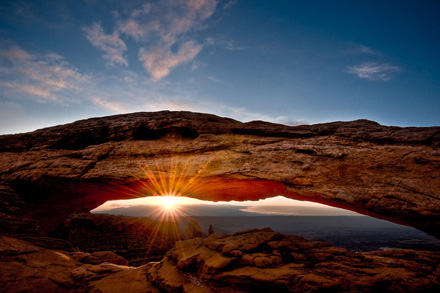
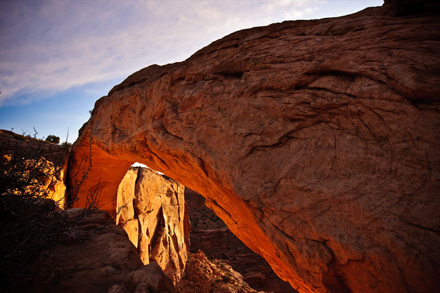
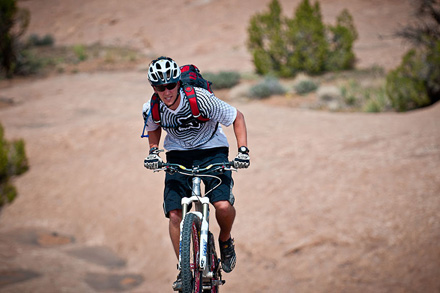
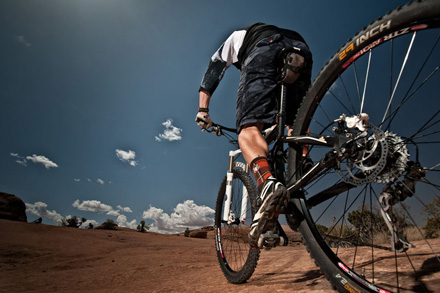
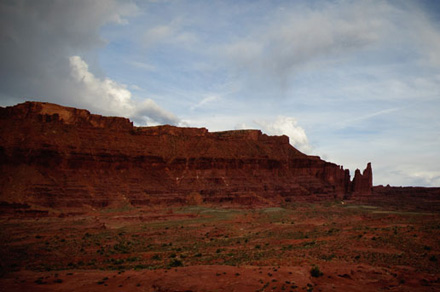
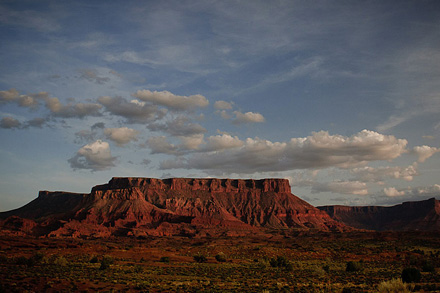
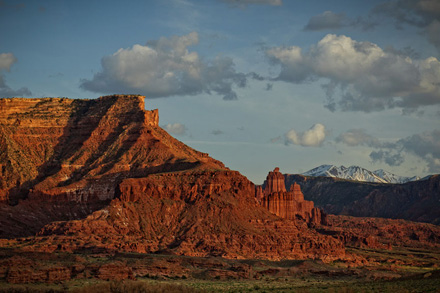

Matt,
Thanks for the 5 landscape photography lessons. Awesome images.
David V.
>Awesome images.
Yes indeed, very impressive images. The sunrise image, below the trees and blue sky is striking, the amount of depth is spectacular.
Great lessons. Thanks Matt!
Hi Matt,
Great post backed up with some stunning images.
Very difficult but if I had to choose my favourites (and I mean ‘had to’) I’d go with #2 and #5 for the landscapes but both of the final lit mountain biker shots; great stuff!
I’m no Landscape Photographer despite having tried it a number of times when I thought I’d go for a bit of ‘time out’ and ‘me’ time on a day taking a break from the portrait work. Landscape Photography is definitely a ‘skill’ and it never ceases to amaze me how ‘non photogs’ think it’s easy; you gotta laugh :)
Utmost respect for Landscape photographers getting out of bed at ‘way too early o’clock’ ; the hard work clearly pays off.
Really like the lit Mountain biker shots that you took using the Quadra’s. Hearing alot about them lately and at this point I’ve held off from ‘investing’ (don’t feel so guilty saying that as opposed to saying ‘buying’) in a set. Clearly the portability is a huge ‘plus’ for them but what about the power output…do you find they pack enough punch?
Anyway Matt, thanks for a great post,
Made for a great read with my morning coffee :)
Cheers,
Glyn
Great read. Thanks for tutorial / points.
Love hands-on lessons like this, thanks! Great shots :)
As always, thanks for your tips / tricks / tutorials etc… Appreciated.
Planning is very important indeed. I always check two weather reports using two different sources to make sure the weather is good (a lot of gray days here in Holland..)
Also, here’s a tip if you’re not a morning person: Don’t go to sleep the day before :-D Staying awake until 4am shouldn’t be that big of a problem if you take a lot of rest the day before (set your alarm a few hours later if possible). Just make sure you don’t get behind the wheels when you’re too tired (don’t want to cause no accidents now do we…)
Hi Matt. Thanks for an insightful posting. Nice to learn more about your photography, other than what we seem from those informative LR/PS killer tips. I don’t often get up early for that morning golden hour but the one thing I do like about it if I have to, is the fact that everything is so quite, peaceful & still at that time.
Love that time of the morning. Sunrise shoot are the best. Its just a shame i need to drag my dad out of bed to drive me!
I think it was worth getting up early when I think I’m going to get results like these. I don’t know what I’ll think when I really got them :)
Just a question, though it’s not about those five lessons. Basically what’s the idea in the post-processing with the off-camera flash bike shots? I’m starting off-camera flash photography and I need some ideas on post-processing. Thanks in advance.
Hi Chip,
The lighting sets you up for some interesting effects after. Basically, it let’s you push the clarity and contrast stuff in Lightroom quite a bit. After Lightroom I went into Photoshop to retouch and remove distractions. Then I ran:
– Nik Color Efex (Tonal Contrast)
– Nik Output Sharpener (mainly for the structure slider which I love)
Finally, I masked the harsh effects away from the skin in Photoshop.
Hope that helps a little :)
– Matt K
Thanks a lot, Matt. :)
Really good post. I don’t really take many landscape shots, but it made me think about what the local ‘Golden Hour’ has to offer. I’m not a morning person so making me think about dawn shoots is a real achievement. Nice one Matt!
Cheers Cosmo.
Thanks for that awesome post and for the usefull insights :) Great Tuesday to you too!
Last January, a friend who volunteers at the Eagle Watch
Institute invited me to go out with him to take some pictures while he
did some counting. We left home here in PA at 4AM to get to the blind
by the reservoir in NY before sunup. There were already several other
photographers there, all with arms-length lenses. They all knew each
other and from what I gathered, they’re there almost every morning
before they head off to their day jobs. As we were leaving, one pulled
out a 3-ring binder with about 50 great photos. Each was better than
the next. Two comments stuck with me. He’s there 60-80 freezing cold
mornings a year in an unheated blind next to a river between
December and March and has been doing that for about 10 years.
That’s the effort it takes to get 50 great shots.
Needs more trees – :-)
I totally agree Jeff! :)
Why do sunrise shoots have to be so darn early anyway?!? That’s what I wanna know! ;-)
Trev J.
Matt, Great post, my dream is to go to Mesa….getting up that early…well, I will do it if I go for sure. Hey Brad, where is Bob? He said he would post after haveing dinner with me :) .
Great post Matt! Thank you!
I LOVE Moab! it’s totally awesome. Arches National Park is one of the most amazing places on Earth.
But as good as the photography is, the mountain biking is even better. I biked there for the better part of a week, and I still cherish those moments as some of the best I’ve ever had on my mountain bike.
What’s even better, is to take your camera along on your bike. There are lots of photo opportunities that regular photographers never see. Totally amazing!
Mark, would love to know how you’re carrying your gear when biking … Thx!
Hi Pam,
This is one of those cases where a quality point and shoot can trump the dslr. I carry my Canon s45 in a cell phone pouch which is velcro’d to my camelbak shoulder strap so it sits on the left side of my chest.
I can actually pull it out, snap a shot, and stuff it back in the pouch while riding, depending on the terrain.
I’ve carried my dslr (separating body & lens) in my camelback, but then it’s more of a “let’s stop here and make an official photoshoot out of it” type of deal.
In terms of tripods, I do not hesitate to set my camera down on a rock or some branches and just use the 10 second timer.
I hope that helps! If you have any questions, you can contact me at mroberg AT gmail DOT com
-Mark
Matt,
Wonderful post! I learned my lesson about getting up early while shooting the famous barn with the grand Tetons in the background. Elbow to elbow. Same thing happened with Mt. Moran sunrise a few days later. I was with other folks and using the same car … Lesson six … Don’t share a vehicle! Lesson seven … Don’t wait for others! Your shots at Moab are fantastic and thanks for sharing them! I’ve really learned a lot from you, Dave and Scott and really appreciate it!
Thanks again,
Dennis
Great advice…the point about “luck” is well taken, not just for the light but also for the crowds. For example, I had a morning in June at your location in Arches and I was the only one there. I can’t imagine more than a couple of people on that small ledge! There are too many locations around Moab and too few sunrises.
Great Post Matt. Really blown away by the Pictures and even though this is info we all know (but some forget on shoot day), the presentation here made it fresh and hammered the point home. Really great Job!
It’s Very Nice Article ! Thank you Scott.
Matt,
I just wanted to say thank you for all of the mentoring and lessons you (and your team) have given over the years. In life, what we leave behind is what is to be most valued and I can honestly say that you and the rest of the folks over at NAPP have really helped advance my enjoyment of photography. My family and freinds have personally benefitted greatly from the knowledge that you have given away.
Thank you very much!!!
Sincerely,
Michael J. Montalto
Joliet, IL
Nailed it. I’ve seen many a landscape post on blogs. Few with this much meat to them. You illustrated it superbly with your photos and your text. This is like a mini workshop in landscape photography. Hopefully everyone will take this advice to heart. And it all works well for wildlife photography too :)
Thanks Scott :)
Matt,
Great list. I can use it to explain myself to many, many friends now. Common questions I get from people, not just photography related….
“Why do you always get places so early?” Answer going forward? See Matt’s #1 on this post. “Why are you packing before we head out?” See Matt’s #2. “Why do you return to the same place you shot only months ago?” See Matt’s #5. “Why are you walking over that way?” See Matt’s #3.
Nobody asks me anything about people cause I’m just so darned anti-social, so we’ll skip number 4. :)
Great advice, Matt! Preliminary scouting usually pays off, which can be days, weeks or even months before as well as getting there an hour earlier than needed. So, a day that turns out to have poor light can at least be a scouting opportunity for another day. And ask other photographers who’ve been there before for their location tips, too. I’ve been to popular locations when other photographers have crowded the prime spots, so be prepared to watch your gear closely. A bumped tripod or kicked gear bag by an eager newby can ruffle a few feathers!
Matt,
Thanks for the great post. I prefer if possible to hike and camp near where I am going to shoot. That way you can be at your spot even earlier and get to places where not as many people can access from the car. Of course this means packing in a lot of stuff needed for camping and photography which is not for everyone.
-S
Do you use any filters when shooting the sunrise?
Hi Peter – A polarizer and some neutral density (for shooting water) are the only filters I carry. Polarizer was probably used on a few of these.
Matt K
Great post, Matt!
I’d add one more thing for those morning shoots — have some food ready to go. I like a Starbucks in a bottle and a few granola bars. Bring a water bottle too!
Harry
The very last paragraph was my favorite. I, too, love landscape photography. I think my work lends itself to the idea of looking out a window, capturing a view or a moment in time.
On the other hand, photographing people sucks. They want really great photos, expect perfection from you, but don’t listen to instruction, whine and moan about clothes being too tight, the sun is in their eyes, it’s too hot/cold, don’t know how to smile, don’t want to spend more than 30 seconds to get the shot because they’re bored, etc. The only thing worse than shooting group or portrait shots is event photography (lighting constantly changing, usually poor/mixed lighting, people glaring at you because the flash got in their eyes, and on and on…)
The landscape doesn’t move. It allows time to setup, review, adjust, get multiple angles. To me, it is a huge stress reliever, and brings an unbelievable amount of peace.
Definitely lots of meat in this article. I like photographing scenery and this inspires me to wake up earlier…
I can definitely relate to the luck factor. There are some locations that I visit because I really enjoy getting different images as there is always something different about it. It could be the weather or a different time of day.
Sometimes you don’t come away with the image you expected due to the weather, but that just forces you to think about how to make the best of the situation you have at the moment.
To me, the real lesson of #5 is to just bring a good attitude. I didn’t expect snow when I visited Zion National Park and neither did the locals. It happened, though. No sense in turning around and going home.
Great tips.
Couple of items based on my experience in Big Bend NP –
1. If you want to do landscapes, get in shape. Most vantage points with best light conditions and crowd-less are a good mile to two miles from parking lot. 95% of the tourists will not walk more than mile from their car.
2. Get the topo maps out and study the lay of the land before getting there. Angles of the sun will change depending on the season. So pick your spots with morning shots or evening shots in mind. Canyons are best done at mid-day.
Now that was a good post.
Matt,
Remember when you were going up the mountains towards the Mesa Arch, a red car drove past all of you guys at a really high speed? That was me, LOL :) I saw a total of 7 cars in front of me and everyone was driving slowly (which is a good idea, because the roads are curvy and dangerous). I immediately knew that I was following photographers…who else would wake up that early and drive through Canyonlands? :)
Anyway, I hope you guys did not hate me for passing you like that, I just wasn’t sure if I had enough time to get to the Dead Horse Point, where I saw you together with the rest of the group as I was leaving the park :) By the way, here is the image of the Dead Horse Point that I took that morning: http://mansurovs.com/dead-horse-point-panorama
And here is a quick log from the trip: http://mansurovs.com/back-from-utah-again
I was going to come and say hi to you, but you were busy with the group and I did not want to interrupt :)
Sincerely,
Nasim
Matt,
Remember when you were going up the mountains towards the Mesa Arch, a red car drove past all of you guys at a really high speed? That was me, LOL :) I saw a total of 7 cars in front of me and everyone was driving slowly (which is a good idea, because the roads are curvy and dangerous). I immediately knew that I was following photographers…who else would wake up that early and drive through Canyonlands? :)
Anyway, I hope you guys did not hate me for passing you like that, I just wasn’t sure if I had enough time to get to the Dead Horse Point, where I saw you together with the rest of the group as I was leaving the park :) By the way, here is the image of the Dead Horse Point that I took that morning: http://mansurovs.com/dead-horse-point-panorama
I was going to come and say hi to you, but you were busy with the group and I did not want to interrupt :)
Sincerely,
Nasim
Holy crap!!! That’s too funny Nasim. I totally remember that. We were cursing you like you wouldn’t believe!!! :)
Just kidding. We definitely understood and no foul words were said. We figured we’d see you at Mesa Arch and that you were just trying to beat the huge photography workshop group there (understandably so).
Too funny! Nice shot by the way. I like Dead Horse a lot. Lots of great places to shoot there.
Take care.
– Matt K
LOL :)
Thank you Matt, maybe I’ll get a chance to meet you next time!
Have a great day!
Nasim
Hey Matt,
The guy in the picture doesn’t look like you and who is this kelby guy mentioned everywhere on this site?:)
Great job filling in and real nice job on the post.
Great post, and great shots. I’m curious about why many of them have the vignetting? Is this a personal choice. When my shots have that it’s because I’m using the wrong lens shade. :) Not being critical, I don’t think it detracts. Just curious if you added it and why.
Yep, it’s added after the fact in Lightroom. More of a personal choice I guess, but I like it :)
Matt K
Great stuff as usual, you have a real knack for getting ideas across in an interesting way that sticks with me. A thought on luck, if I may: I believe the luck comes after the photo-artist uses her Eye to See the composition, colors, textures, balance, light, shadows, and all the other elements, along with her imagination to envision what the finished piece MIGHT look like. Then with good luck, she uses her skill, planning, patience, and Eye to shoot, look, change, shoot, look, move, and so on to get something close to what she envisioned in the first place. It’s that Eye thing that gives me the most trouble, at the shoot but especially in post processing (e.g., how do I want to crop this image so it brings out the story?). All your stuff on technique and procedure is great, but I sure would like to see a little more about WHY you are doing something in y’alls tips and blogs and classes. I don’t know if other relative neophytes feel this way or not, but it sure would help me.
You guys and gals at Kelby are so good at what you do and you give so much away for free that I am amazed. Keep doing what you are doing, it’s helping a lot of people!
Thanks,
Tom Hargreaves
I don’t know if my comments were published as I do not see them.So I will do it again.
An interesting read as I find it amazing that you have to get up early to get a good spot to photograph.I personally would not even think of going to a place like that. But I guess I am fortunate to be living in Northern Ontario where by I can drive an hour or less and maybe walk a 1/2 mile into where I want to photograph and not have to worry about all these people trying to take the same photos as I.I do most of my shooting late evening as I love the lighting then and I can photograph until dark as the lighting changes.
Thanks, Matt for the interesting post. If you are not an early bird, try going there right after the rain has stopped http://farm5.static.flickr.com/4062/4276857159_bd8733623c_o.jpg
Good writeup, Matt.
I don’t believe in luck. I believe in blessings, and I believe in making it happen.
John
Loved your blog today but the last paragraph says it all regarding landscape photography. Image #7 is flat out awesome.
Matt great tips, could you indulge some of us amateurs the settings that you used that day, especially the one of the sunrise. That’s a great shot.. Also did you use any filters for that morning shot?
It’s information like this that gives us all, the inspiration to go out and create beautiful photographs. Keep up the good work and who needs scott. You guys are just as knowledgeable.
Hey Scott,
The photo you took through a Window of Turret Arch in Arches National Park, did you have to climb over a ledge to get the perfect framing angle of the Turret Arch through that big window? I did, and I damn near dropped my Hasselblad 503CW! There weren’t as many people when I went 10 years ago in October. But I do know what you mean by getting there early and grab a primo spot. Great photos by the way!!
Terry
Hey Matt,
Thanks for the mini workshop on landscapes! I’m not sure why, but I just don’t get into shooting landscapes, but I’m trying to teach myself to. I enjoy seeing really great landscapes and I stand in awe at Ansel’s BWs, and I really love being there in the moment, like Arches Park, but never think, “I’ve got to catch that!”
While at Arches last August, we were hiking up to Delicate Arch and this guy was huffing 80-90 lbs of gear up there and I was thinking, “seriously”? (Another reason to leave early, it took longer than I thought to get up there!) Props to the people that love to shoot it and one day, maybe I’ll want to shoot it too!
Maybe I should do a landscape workshop…
Best,
Zac
Oh I forgot to ask, do you ever use grad filters and the such? Or do you just do it in post?
Hey Zac,
I hate ND grads (blasphemy to some, I know). :)
They’ve ruined way more photos for me than they’ve helped. If you overexpose the sky a little than its really easy to bring back in post and I get much better results then I ever have using the grads.
Matt K
Great tips and fantastic images. Thanks for this post!
Ohhhh . . . we were just in Moab for a week for the Spring Break Jeep Safari. Hmmmmm . . . somehow my pics just don’t look quite like yours. However, I am still pretty darn happy with them because it is hard to go wrong in Moab whether in a canyon or on top of Dead Horse Point, I am happy with all of my many panos. Lightroom can make this amateur seem like a pro to my non-photography friends!
Thanks for the lessons!!
Hey Matt,
What a fantastic read! I love landscape photography and you gave some really excellent tips and ideas. We were in Moab back in Nov 08 (drove down there after the Bozeman DWLS), and there was so many places to take interesting photos. Of course, they don’t compare to your shots, incredible!
Thanks for sharing.
Matt,
I was at Mesa Arch in the fall and that’s exactly what I saw. A pile of photographers all waiting for the sun. Great comments on all your points.
Barry
Hey Matt,
awsome pictures and some great tips. My absolute favorite is mesa2, can’t stop looking at it :).
Florian
Matt,
Great article and great pictures. I was at Mesa Arch for sunrise on or about 4/20. I even looked in your group shot to see if I was in there!
Question on the sunrise starburst under the arch. How did you do it? I did a lot of bracketing that morning and have the sunburst, but can’t coax a shot like this out of them.
Any hints?
Thanks,
Rick
Thanks Rick. Got the sunburst from shooting at f/16 with the Nikon 14-24 lens. One thing I found out on this trip is that the nano crystal coating on some of those newer lenses makes a huge difference with flare. First off, it gave me an excellent looking starburst. Second, it really cut down on a lot of the flare that I got if I used say, the 10-24mm lens (which I did try).
Thanks,
Matt
Thanks, Matt
I was shooting with a Canon 50D and the 17-45L at f/18. I have a decent starburst (although not as nice as yours and way more flare), but my question was more on how you got both the starburst as well as details in the arch, etc. Did you use HDR? If not, then how did you do it? If so, can you provide a little more detail on how many shots at what EV spread? The picture is gorgeous and I struggle to find the usual HDR “tells”. Really a nice job. Hoping I can tease a composite from one of my bracketed sets that looks close. So far, I have not been able to get there
Thanks!
Rick
Awesome photos and some great tips & advice, Matt!!! I love landscape photography! Your shots are incredible! So inspiring! I’m going to UT next month, I’m gonna get up early and remember what you said here! Thanks again!
Have a great day!! :)
-Anna
Great shots Matt! I really like the Mesa Arch sunrise- did you use a filter to get the star burst like rays coming off the sun?
Keep up the great work!
– Dan
Nope. No filter. Shot the Nikon 14-24mm at f/16 to get it. See my comment reply to Rick a few above this one and you’ll get a little more insight on why the starburst looks so good.
Thanks,
Matt
I would have throttled that one guy who was 20 feet in front of all the other photographers and right in the arc of the arch! I just can’t believe the arrogance and self-centered nature of some folks who are willing to inconvenience everyone else so they can do what they want.
How true. And it happens more often than not. I usually post a sign now that say ” Please respect other fellow photographer’s position…PLEASE!”.
How do u know he didn’t excuse himself before getting in the way?
These are great tips most of which I learned the hard way… But the most important thing I got out this article is a new location to shoot… I’ve never been there before and now I’m marking it in my book of places I would like to shoot…
This article was great keep up the great training and great photography…
great Photos. I hope to make it there some day. I will take your advise.
Some good advice Matt.
But you have to ask the question with so many photographers lining up for that cliche shot
of mesa arch. Why bother Its just a me too shot? I hate crowds I would just pack up my tripod and head elsewhere.
What’s wrong with a “me too” shot. Some people love getting out to a great location (even though others have shot it before) and shooting it for themselves. I can attest to the fact that it means something different when it’s your own photo. And the people that come to my house and see it on my wall have no idea how many other people took the photo. You gotta remember, photographers see (and know) things differently than the rest of the world looking at our photos.
As for crowds, of course nobody likes them right? I’m pretty sure you’re not alone. I’ve never heard anyone say I wish there were more people here shooting. But with some courtesy and preparation you can slip in, get your photo and be out shooting other things in a few minutes.
– Matt
I guess the early getting thing might be the hardest part of it all! :)
Very nice advice indeed! Thanks for that!